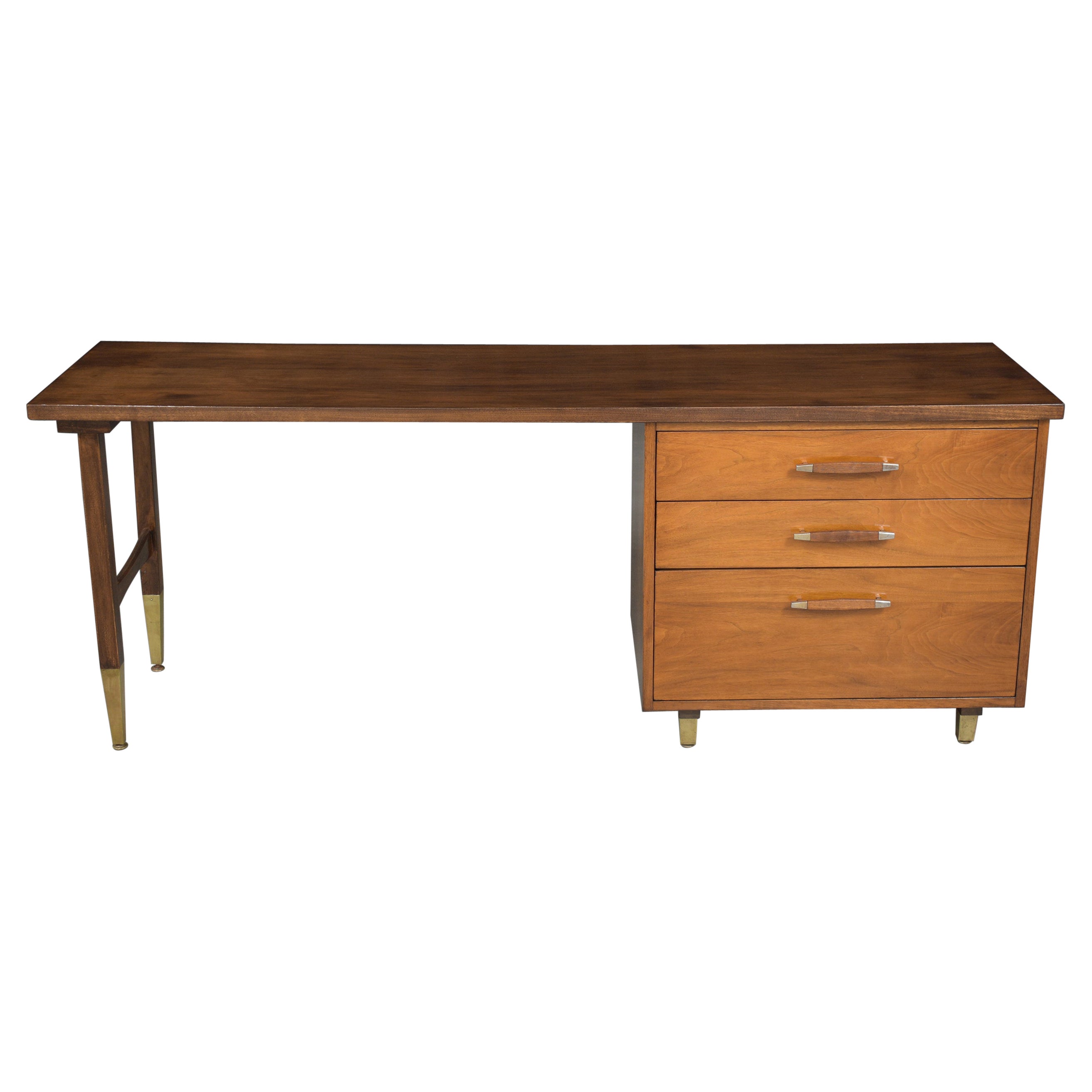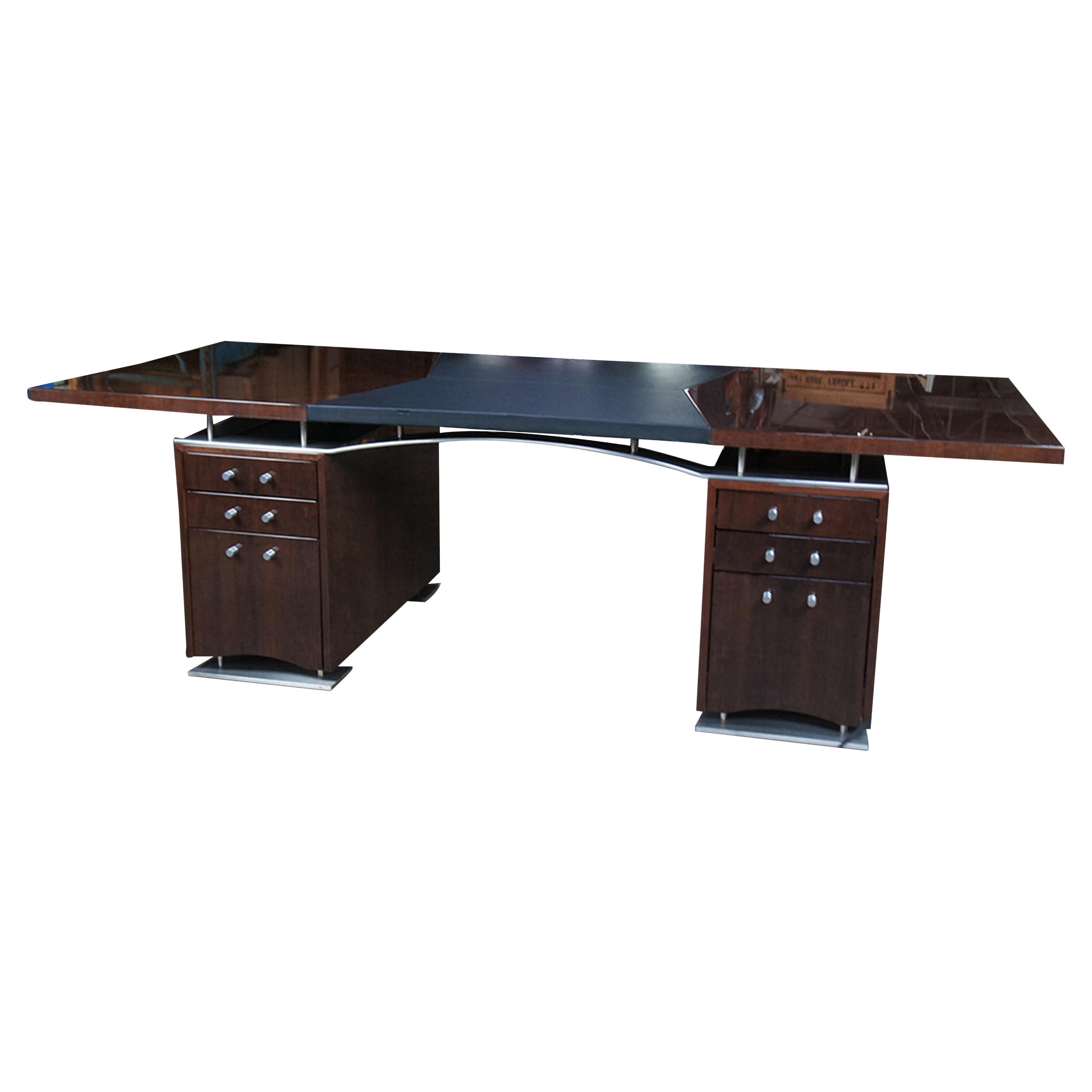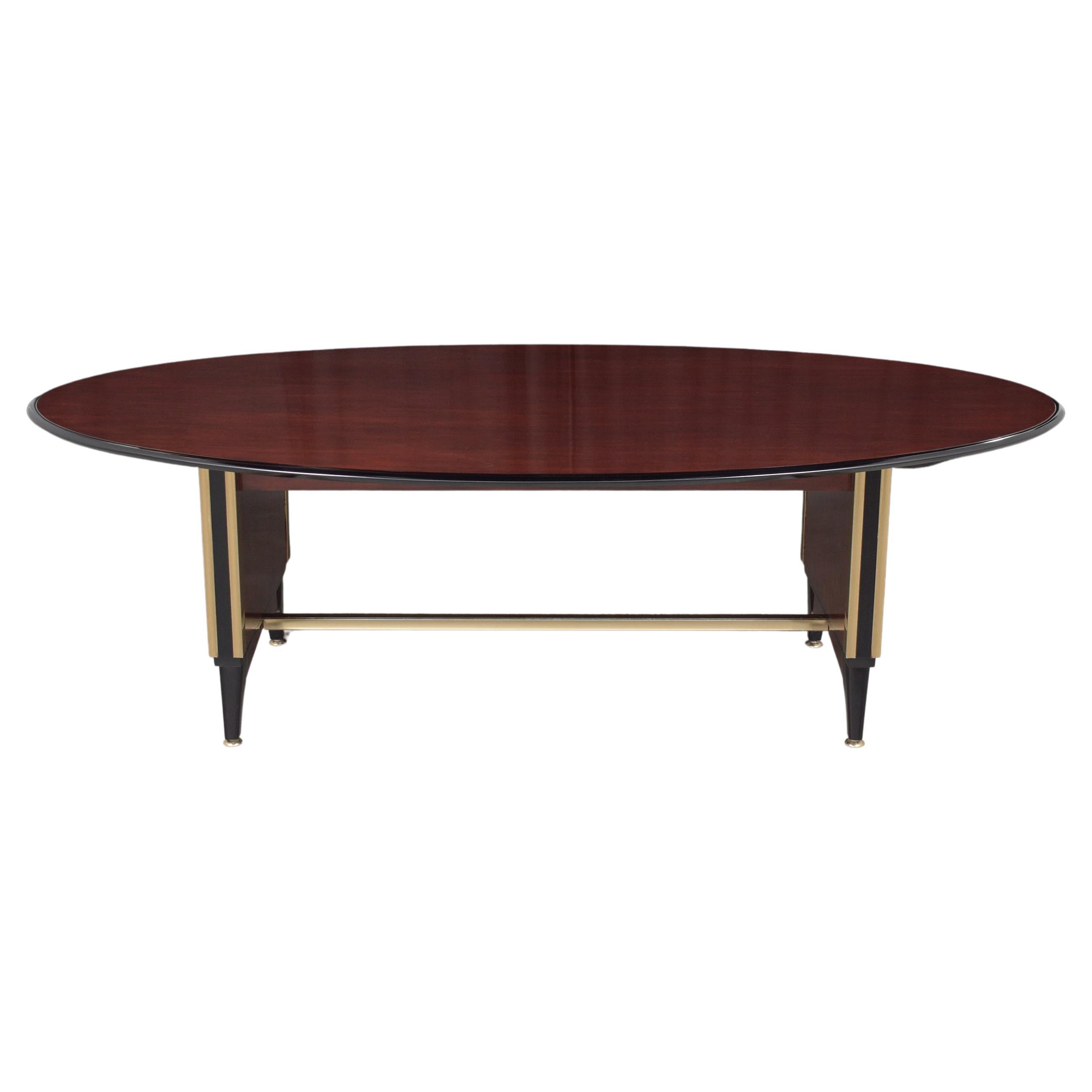Items Similar to 1960s French Executive Desk: Art Deco Mahogany Design with Ebonized Accents
Want more images or videos?
Request additional images or videos from the seller
1 of 12
1960s French Executive Desk: Art Deco Mahogany Design with Ebonized Accents
About the Item
Step into a harmonious fusion of form and function with our 1960s French Executive Desk, a testament to Art Deco brilliance. Skillfully constructed from mahogany wood, this piece radiates vintage charm, having been diligently restored, stripped, and refinished by our specialized in-house craftsmen. Flaunting a sleek silhouette, the desk is bathed in a deep mahogany hue, which stands in striking contrast to its ebonized molding and accent details, all protected with a lustrous high-gloss lacquer finish. Apart from its aesthetic allure, the desk champions practicality with a generous rectangular tabletop and twin side drawers, offering ample room for all your work essentials. Inside, a fresh lacquer coat revives its appeal. Anchored on pedestal legs embellished with brass molding and chic leg caps, the desk promises both stability and panache. An embodiment of Art Deco sophistication, this executive desk is poised to enhance any home or office setting, promising service and style for years ahead.
- Dimensions:Height: 30 in (76.2 cm)Width: 75 in (190.5 cm)Depth: 39 in (99.06 cm)
- Style:Mid-Century Modern (Of the Period)
- Materials and Techniques:
- Place of Origin:
- Period:
- Date of Manufacture:1960
- Condition:Refinished. This table has been professionally refinished.
- Seller Location:Los Angeles, CA
- Reference Number:
About the Seller
4.9
Platinum Seller
These expertly vetted sellers are 1stDibs' most experienced sellers and are rated highest by our customers.
Established in 1975
1stDibs seller since 2013
1,855 sales on 1stDibs
Typical response time: 2 hours
- ShippingRetrieving quote...Ships From: Los Angeles, CA
- Return PolicyA return for this item may be initiated within 14 days of delivery.
More From This SellerView All
- 1960s Mid-Century Modern Walnut Executive Desk with Chrome AccentsLocated in Los Angeles, CAExperience the timeless elegance of our 1960s Mid-Century Modern Executive Desk, masterfully constructed from select walnut wood. This vintage writing table, restored to impeccable c...Category
Vintage 1960s American Mid-Century Modern Desks
MaterialsBrass
- 1950s French Executive Desk: The Epitome of Mid-Century Elegance and FunctionLocated in Los Angeles, CAElevate your work setting with the sheer sophistication of our 1950s French executive desk. A true masterpiece, handcrafted from the finest mahogany, this desk stands as a testament ...Category
Vintage 1960s French Art Deco Dining Room Tables
MaterialsMetal, Brass
- 1950s Art Deco Pedestal Desk in Walnut & Ebonized Finish with Brass AccentsLocated in Los Angeles, CAImmerse yourself in the elegance of the past with our 1950s Art Deco Pedestal Desk, a perfect blend of historical charm and modern restoration. ...Category
Vintage 1950s American Art Deco Desks
MaterialsBrass
- Restored 1960s Mid-Century Modern Oak and Brass Executive DeskLocated in Los Angeles, CAStep into the world of mid-century modern design with our beautifully restored 1960s executive desk. This exquisite piece, hand-crafted from a blend of oak wood and brass, is a testa...Category
Vintage 1960s American Mid-Century Modern Desks and Writing Tables
MaterialsBrass
- 1850s Spanish Extendable Dining Table: Ebonized Solid Wood with French DesignLocated in Los Angeles, CAStep into a world of refined elegance with our Spanish-style dining table, a masterful representation of 1850s design and craftsmanship. Expertly handcrafted from solid wood and brou...Category
Vintage 1910s French Spanish Colonial Dining Room Tables
MaterialsWood, Oak, Lacquer
- Harvey Probber Executive Desk: Mid-Century Elegance Meets Modern FunctionalityBy Harvey ProbberLocated in Los Angeles, CAExperience the sophistication of the 1960s with our beautifully restored Harvey Probber Mid-Century Modern Executive Desk. Crafted from the finest mahogany, this desk exemplifies the...Category
Vintage 1960s American Mid-Century Modern Desks
MaterialsMarble, Metal, Steel
You May Also Like
- French Art Deco Mahogany TableBy Jules LeleuLocated in Tourcoing, FRFrench Art Deco mahogany table with U base called "cradled " feet. Ideal as a dining table, it will be a perfect and amazing office desk.Category
Vintage 1930s French Art Deco Dining Room Tables
MaterialsMahogany
- Rustic Solid Teak Desk / Table, France 1960sLocated in Echt, NLRustic desk / table in very good original condition. This desk / Table is made from rustic solid teak wood which has a stunning woodgrain and patina. The sides are connected to the top with beautiful joints. Its reduced shape creates a raw simplicity. It is minimalist and pure, avoiding any non-sense and almost has Japanese design character. We offer a variety of insured shipping services, ask us for the possibilities and competitive pricing. If you have any questions about our shipping options or this item please feel free to contact us. The style reminds of the French designers Pierre Chapo...Category
20th Century French Mid-Century Modern Dining Room Tables
MaterialsWood, Teak
- Antique French Art Deco Dining Table or Writing Desk in Mahogany Wood, 1930sLocated in Detroit, MIThis French Art Deco carved mahogany dining table or large writing desk from the early 20th century features a beautiful geometric marquetry wood tabletop with arrow pattern supporte...Category
Early 20th Century Unknown Art Deco Dining Room Tables
MaterialsMahogany, Wood
- Dakota Jackson French Art Deco Postmodern Mahogany Executive Partners Desk 96"By Dakota JacksonLocated in Dayton, OHVintage Dakota Jackson post modern Art Deco style executive partners desk featuring mahogany with leather insert and stainless steel frame. A V-Shape pattern veneer top with Black Leather inset. 2 pedestal cabinets below: each with 2 standard drawers and 1 file drawer, front and back. Polished Stainless Steel drawer pulls, post, floor plates, and arced trestle supporting desktop. DJ Chelsea Black Leather, Polished Polyresin finish. Dakota Jackson (born August 24, 1949) is an American furniture designer known for his eponymous furniture brand, Dakota Jackson, Inc.,[1] his early avant-garde works involving moving parts or hidden compartments,[2][3] and his collaborations with the Steinway & Sons piano company.[1] Jackson helped establish the art furniture movement in 1970s SoHo,[4][5] later becoming a celebrity designer in the 1980s.[6][7][8] His background in the world of stage magic helped him get his first commissions and is often cited as the source of his point-of-view.[6][9] Early life Dakota Jackson was born on August 24, 1949, and grew up in the Rego Park neighborhood of Queens, New York. Stage Magic Jackson's father, Jack Malon, was a professional magician.[10] Mr. Malon learned the trade from his own father, who studied stage magic in early 20th century Poland.[1] Jackson began studying magic at a young age and sometimes performed with his father.[11] Jackson's name, in fact, grew out of a road trip to Fargo, North Dakota.[11] Throughout his adolescence and into his early 20s, Jackson immersed himself in the world of magic.[2] In 1963, Jackson began to perform in talent shows at his junior high school, William Cowper JHS 73 (which is known today as The Frank Sansivieri Intermediate School),[12] and at children's birthday parties.[13] Jackson also began to build his own props, including large boxes for sawing a woman in half and small boxes from which doves would emerge in full flight.[11] Jackson acknowledges the importance of these early experiences with magic to his later career as a furniture designer: "The demands of performance taught me how to discipline myself to achieve aesthetic ends."[1][2][14] After Jackson graduated from Forest Hills High School in 1967, he continued performing as a magician, working in art galleries, night clubs, touring in the Catskills, and giving private performances at society events.[2][13][15] When he was 17, Jackson had studied with magician Jack London to learn the dangerous bullet catch trick.[16] "What appealed to me was the notion of doing things that appeared miraculous" Jackson once recalled.[6] "I was interested in spiritualism. I was interested in things like bullet catching, things that really challenged individual sensibilities, that were frightening, on the edge."[2] He didn't find the opportunity to perform the trick publicly until a decade later at Jackson's final professional performance as a magician.[1] It was documented in Andy Warhol's Interview (magazine), in a story titled "Dakota Jackson bites the bullet."[1][16] Jackson admits that he sometimes tires of references to his magician background, although he acknowledges it as an important part of his history.[2] The Downtown Arts Scene In the late 1960s, Jackson moved into a loft on 28th Street in Chelsea.[1][17] Jackson became part of the Downtown scene, a community of "artists, dancers, performers, and musicians" who moved to the neighborhood for the cheap rent and social life.[1][8][17][18] In October 1970, Jackson performed with the Japanese group Tokyo Kid Brothers at New York's La MaMa Experimental Theatre Club (also known as Café La MaMa) in a rock musical production called "Coney Island Play" ("Konī airando purē).[19] The show explored themes of cross-cultural communication and understanding[19] and was a follow up to the group's debut performance of "The Golden Bat" at La MaMa earlier that summer.[20][21][22] Jackson played the part of a "clever conjurer."[19] Over the next few years, Jackson became interested in minimalist dance and performed in the dance companies of Laura Dean and Trisha Brown.[2][15][23] Jackson credits his exposure to minimalism and minimalist dance in particular as having had a strong influence on his approach to design; in 1989, Jackson told the Los Angeles Times: For me the essential fineness of a design is in the idea, not the object itself ... In minimalism, the object is pared down to its basic meaning by stripping away all the excrescence ... —those elements that do not contribute to the pure idea.[24] Design career In the early 1970s, as he experimented with performance and dance, Jackson began branching out as a special effects consultant to other magicians, film producers, and musicians[2][23] such as Donna Summer.[6][9] The loft also gave Jackson an opportunity to apply his creativity and building skills: "These were times when lofts were not ... luxury condominiums. These were tough, tough raw spaces ... and we artists, bohemians, creative people, we created our environment. So I had to build".[17][25] Recognizing his skills as a builder, Jackson decided to shift away from performance and become a full-time maker.[1][15][17] He began making a variety of objects, including furnishings for other artists and magic boxes with hidden compartments for art collectors and galleries.[17][24] Jackson's social connections helped spread word about his work[15] and this led to his first commissions.[1] Early Commissions Desk for John Lennon by Dakota Jackson In 1974, Jackson's career as a designer began when Yoko Ono asked him to build a desk with hidden compartments for husband John Lennon.[26] "She wanted to make a piece of furniture that would be a mystical object; that would be like a Chinese puzzle," Jackson recalled in a 1986 interview published in the Chicago Tribune.[6] The result was a small cubed-shaped writing table with rounded corners reminiscent of Art Deco era style.[15] Touching secret pressure points opened the desk's compartments.[23] This commission helped build Jackson's reputation and allowed him to merge his experience as a magician and performer with his developing interest in furniture.[27] In 1978, a bed designed for fashion designer Diane von Furstenberg garnered Jackson even more notoriety.[8][10][28] [29] Called "The Eclipse", the bed was described in The New Yorker as "large, astounding, sumptuous, with sunbursts of cherry wood and quilted ivory satin at head and foot."[10] A lighting system positioned behind the headboard switched on automatically at sunset and spread out rays of light "like an aurora borealis,"[2][17] which grew brighter and brighter until turning off at 2 am.[23][30] Commissions like these continued to come in[8] and Jackson soon became known as a designer to the rich and famous.[30] Some of his other clients from this period included songwriter Peter Allen, Saturday Night Live creator and producer Lorne Michaels, Rolling Stone publisher Jann Wenner, and soap opera actress Christine Jones.[8] The American Art Furniture Movement and the Industrial Style In the late 1970s, Jackson was among a small group of artists and artisans producing and exhibiting hand-made furniture in New York.[5][31] Jackson and his peers were part of the "American Art Furniture Movement," a group sometimes called the "Art et Industrie Movement,"[32] named after the leading art furniture gallery of the era,[32] Art et Industrie, founded by Rick Kaufmann in 1976.[33] In a 1984 Town & Country article titled "Art You Can Sit On," Kaufmann said he created the gallery to "serve as a locus to the public for artists and designers creating new decorative arts."[31] The works on display were "radical objects" that drew from a number of fine art traditions, including "Pop, Surrealism, Pointillism and Dada [which were] "thrown together with the severe lines of the Bauhaus and the Russian avant-garde, mixed with Mondrian's color and filtered through a video sensibility—all to create a new statement."[31] The article described Jackson as a "ten-year veteran of the genre" and pointed to the "clean forms and quiet colors" of his furniture.[4] Jackson showed a variety of industrial-looking lacquer, metal, and glass works at Art et Industrie, including his Standing Bar (also known as the Modern Bar),[33] a lacquered cabinet that Jackson designed in 1978 for his wife (then-girlfriend) RoseLee Goldberg.[13] Other works from this period include the T-Bird Desk, Self-Winding Cocktail Table, and the Saturn Stool...Category
Late 20th Century Art Deco Desks and Writing Tables
MaterialsStainless Steel
- 1960s Sophisticated Knoll Executive Partners DeskBy KnollLocated in Chula Vista, CA1960s Classic Knoll Desk sophisticated large executive partners desk with chrome steel four-star base Two drawers on each side (as it can be used as a partners team desk). Unmarked....Category
Vintage 1960s American Mid-Century Modern Desks and Writing Tables
MaterialsChrome
- Franco Albini for Poggi Table or Desk, Italy, 1960sBy Franco Albini, PoggiLocated in Almelo, NLFranco Albini for Poggi table or desk, Italy, 1960s Walnut table TL22 model by Franco Albini for Poggi Italy 1960s. It is in excellent condition, with a minor patina on the wood parts. This unique table or desk would be an eye-catching addition to any interior, such as a living room, family room, screening room, or office. It also perfectly fits in a hospitality or corporate location like a boutique hotel lobby or luxury loft. When you choose for used mid...Category
Mid-20th Century Italian Mid-Century Modern Dining Room Tables
MaterialsWood, Walnut
Recently Viewed
View AllMore Ways To Browse
Mid Century Modern Side Table With Storage
Mid Century Modern Wood Accent Table
Mid Century Walnut Decor
Vintage Wood Molding
Walnut Accent Table Modern
Mid Century Modern Ebonized Dining Table
Mid Century Modern Ebonized Dining Tables
Midcentury Modern Ebonized Dining Table
Mid Century Modern Dining Room Tables Ebonized
Mid Century Dark Wood Dining Tables
Mahogany Two Pedestal Dining Table
Walnut Wood Accent Tables
Ebonized Walnut Dining Table
Deco Mahogany Dining Table
Dark Stain Dining Table
Ebonized Wood French Polish
1960s Dining Table Rectangular
Lacquered Mahogany Dining Table





